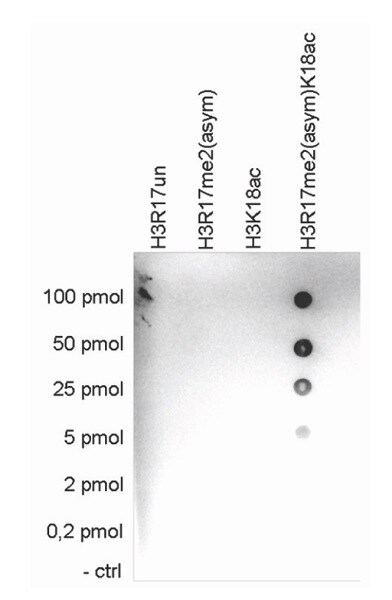Anti-Histone H3 (asymmetric di methyl R17, acetyl K18) antibody (ab231674)
Key features and details
- Rabbit polyclonal to Histone H3 (asymmetric di methyl R17, acetyl K18)
- Suitable for: WB, ChIP, Dot blot, ICC/IF, ChIP-sequencing
- Reacts with: Mouse, Human, Recombinant fragment
- Isotype: IgG
Overview
-
Product name
Anti-Histone H3 (asymmetric di methyl R17, acetyl K18) antibody
See all Histone H3 primary antibodies -
Description
Rabbit polyclonal to Histone H3 (asymmetric di methyl R17, acetyl K18) -
Host species
Rabbit -
Tested applications
Suitable for: WB, ChIP, Dot blot, ICC/IF, ChIP-sequencingmore details -
Species reactivity
Reacts with: Mouse, Human, Recombinant fragment -
Immunogen
Synthetic peptide corresponding to Human Histone H3 (asymmetric di methyl R17, acetyl K18) conjugated to keyhole limpet haemocyanin.
Database link: P68431 -
Positive control
- ICC/IF: NIH/3T3 cells. WB: Whole cell and histone extracts from HeLa cells. ChIP: HeLa cells.
Properties
-
Form
Liquid -
Storage instructions
Shipped at 4°C. Store at +4°C short term (1-2 weeks). Upon delivery aliquot. Store at -20°C long term. Avoid freeze / thaw cycle. -
Storage buffer
Preservatives: 0.05% Sodium azide, 0.05% Proclin 300
Constituent: PBS -
 Concentration information loading...
Concentration information loading... -
Purity
Affinity purified -
Clonality
Polyclonal -
Isotype
IgG -
Research areas
Images
-
ChIP was performed as described above using 1 µg of ab231674. The IP’d DNA was subsequently analysed on an Illumina Genome Analyzer. Library preparation, cluster generation and sequencing were performed according to the manufacturer’s instructions. The 36 bp tags were aligned to the human genome using the ELAND algorithm. Image shows the peak distribution along the complete human X-chromosome and a zoomin to a 500 kb region (2A and B), and in two regions on chromosome 14 and 3 surrounding the c-fos and EIF4A2 positive control genes (2C and D, respectively).
-
ChIP assays were performed using HeLa (Human epithelial cell line from cervix adenocarcinoma) cells, ab231674 and optimized PCR primer pairs for qPCR. ChIP was performed using sheared chromatin from 1,000,000 cells. A titration consisting of 1, 2, 5 and 10 µg of antibody per ChIP experiment was analyzed. IgG (2 µg/IP) was used as a negative IP control. Quantitative PCR was performed with primers for the promoters of the active EIF4A2 and c-fos genes, used as positive controls and for the inactive MYOD1 gene and the Sat2 satellite repeat, used as negative controls. Image shows the recovery, expressed as a % of input (the relative amount of immunoprecipitated DNA compared to input DNA after qPCR analysis).
-
Dot Blot analysis was performed with peptides containing other histone modifcations and the unmodifed H3R17K18. One hundred to 0.2 pmol of the respective peptides were spotted on a membrane. ab231674 was used at a dilution of 1:20,000.
-
All lanes : Anti-Histone H3 (asymmetric di methyl R17, acetyl K18) antibody (ab231674) at 1/1000 dilution
Lane 1 : HeLa (Human epithelial cell line from cervix adenocarcinoma) whole cell extracts at 25 µg
Lane 2 : HeLa (Human epithelial cell line from cervix adenocarcinoma) histone extracts at 15 µg
Lane 3 : Recombinant histone H2A at 1 µg
Lane 4 : Recombinant histone H2B at 1 µg
Lane 5 : Recombinant histone H3 at 1 µg
Lane 6 : Recombinant histone H4 at 1 µgDilution buffer: TBS-Tween containing 5% skimmed milk.
-
 Immunocytochemistry/ Immunofluorescence - Anti-Histone H3 (asymmetric di methyl R17, acetyl K18) antibody (ab231674)
Immunocytochemistry/ Immunofluorescence - Anti-Histone H3 (asymmetric di methyl R17, acetyl K18) antibody (ab231674)NIH/3T3 (Mouse embryo fibroblast cell line) cells stained for Histone H3 (asymmetric di methyl R17, acetyl K18) using ab231674 at a dilution of 1/500 in ICC/IF.
Cells were fxed with 4% formaldehyde for 10 minutes and blocked with PBS/TX-100 containing 5% normal goat serum and 1% BSA. Secondary used is an Alexa Fluor®488-conjugated Anti-Rabbit. The middle panel shows staining of the nuclei with DAPI. A merge of the two stainings is shown on the right.






















